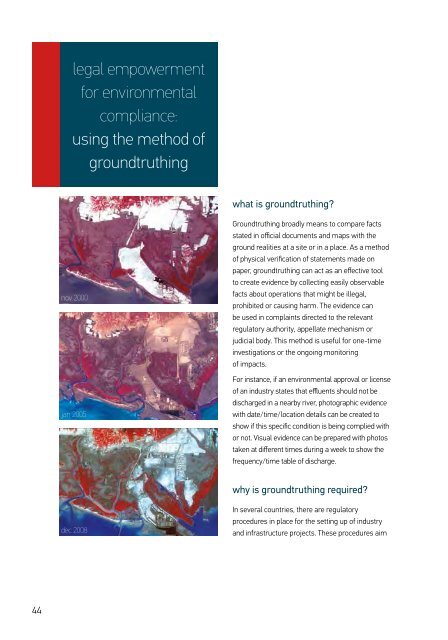ENFORCEMENT GAP
2bl6Lc0
2bl6Lc0
You also want an ePaper? Increase the reach of your titles
YUMPU automatically turns print PDFs into web optimized ePapers that Google loves.
to reduce or mitigate the environmental and social<br />
fields, construction of retaining walls, restricting<br />
legal empowerment<br />
for environmental<br />
compliance:<br />
using the method of<br />
groundtruthing<br />
nov 2000<br />
jan 2005<br />
dec 2008<br />
what is groundtruthing?<br />
Groundtruthing broadly means to compare facts<br />
stated in official documents and maps with the<br />
ground realities at a site or in a place. As a method<br />
of physical verification of statements made on<br />
paper, groundtruthing can act as an effective tool<br />
to create evidence by collecting easily observable<br />
facts about operations that might be illegal,<br />
prohibited or causing harm. The evidence can<br />
be used in complaints directed to the relevant<br />
regulatory authority, appellate mechanism or<br />
judicial body. This method is useful for one-time<br />
investigations or the ongoing monitoring<br />
of impacts.<br />
For instance, if an environmental approval or license<br />
of an industry states that effluents should not be<br />
discharged in a nearby river, photographic evidence<br />
with date/time/location details can be created to<br />
show if this specific condition is being complied with<br />
or not. Visual evidence can be prepared with photos<br />
taken at different times during a week to show the<br />
frequency/time table of discharge.<br />
why is groundtruthing required?<br />
In several countries, there are regulatory<br />
procedures in place for the setting up of industry<br />
and infrastructure projects. These procedures aim<br />
impacts of these projects. This is done through<br />
a system of conditional approvals or by binding<br />
the project to a list of mandatory safeguards that<br />
are to be implemented by them. Groundtruthing<br />
is required to assess if these conditions and<br />
safeguards are being complied with and resulting<br />
in better outcomes.<br />
There are also MoUs (Memorandum of<br />
Understanding), lease agreements and contracts<br />
that are agreed upon and signed between a project<br />
developer, governments and communities. These<br />
documents may also contain several commitments<br />
made by various parties. Groundtruthing is useful to<br />
monitor if these commitments are being upheld and<br />
to what effect.<br />
who can groundtruth?<br />
The groundtruthing method can be used at three<br />
different levels:<br />
• Public spirited individual or small teams:<br />
E.g. environmental or rights based organisations<br />
along with key local “informants”.<br />
• Group of Community representatives:<br />
E.g. affected people or village council members.<br />
• Legal Empowerment/Paralegal programs<br />
for Environmental Justice (EJ): E.g. affected<br />
communities with paralegals collect evidence of<br />
impacts and seek remedies.<br />
at what stage to groundtruth?<br />
• Pre approval: To confirm the facts and baselines<br />
presented to obtain approvals E.g. Environment<br />
Impact Assessment report and compliance with<br />
consent provisions.<br />
• During construction: Corroborating the<br />
safeguards and conditions under which a project<br />
should be built. E.g. damages to households or<br />
sacred sites, dumping in rivers or agricultural<br />
encroachments and rehabilitation plans.<br />
• Post approval: Monitoring the compliance of legal<br />
conditions of a license, approval and agreements<br />
even as operations are underway, E.g. preventing<br />
water pollution, safeguards related to transportation<br />
of raw materials, functional emission control<br />
devices and regulating withdrawal of groundwater.<br />
what to groundtruth?<br />
Identification of items for groundtruthing is<br />
an essential component of the method. The items<br />
need to be selected carefully. Some general<br />
principles, which could help with selection, include:<br />
• Availability of official data: This method can<br />
be most effective when approval letters, impact<br />
assessment reports and safeguard plans are<br />
available to compare conditions with said impacts.<br />
• Access to site: The method is also dependent<br />
on the possibility of access to the sites of impact<br />
to collect observable evidence like photographs,<br />
water samples, and GPS (Global Positioning<br />
System) coordinates.<br />
• Knowledge of institutional links: The method<br />
also requires a person involved in evidence<br />
collection to have knowledge on the institution<br />
to which the proof will be presented. Different<br />
institutions might require their own formats or<br />
stringency of evidence types and complaints.<br />
• Multiple evidence: It is best to groundtruth those<br />
statements for which multiple pieces of evidence<br />
can be provided. A thumb rule to persuade<br />
a regulatory agency or remedial body is to collect<br />
three pieces of evidence per violation, illegality or<br />
impact. This is called triangulation.<br />
E.g. a photograph of effluent discharge can be<br />
supported by an earlier show-cause notice of<br />
a regulatory agency or an approval condition<br />
along with media reports attributing the action to<br />
particular activity/agency/project.<br />
44 45


